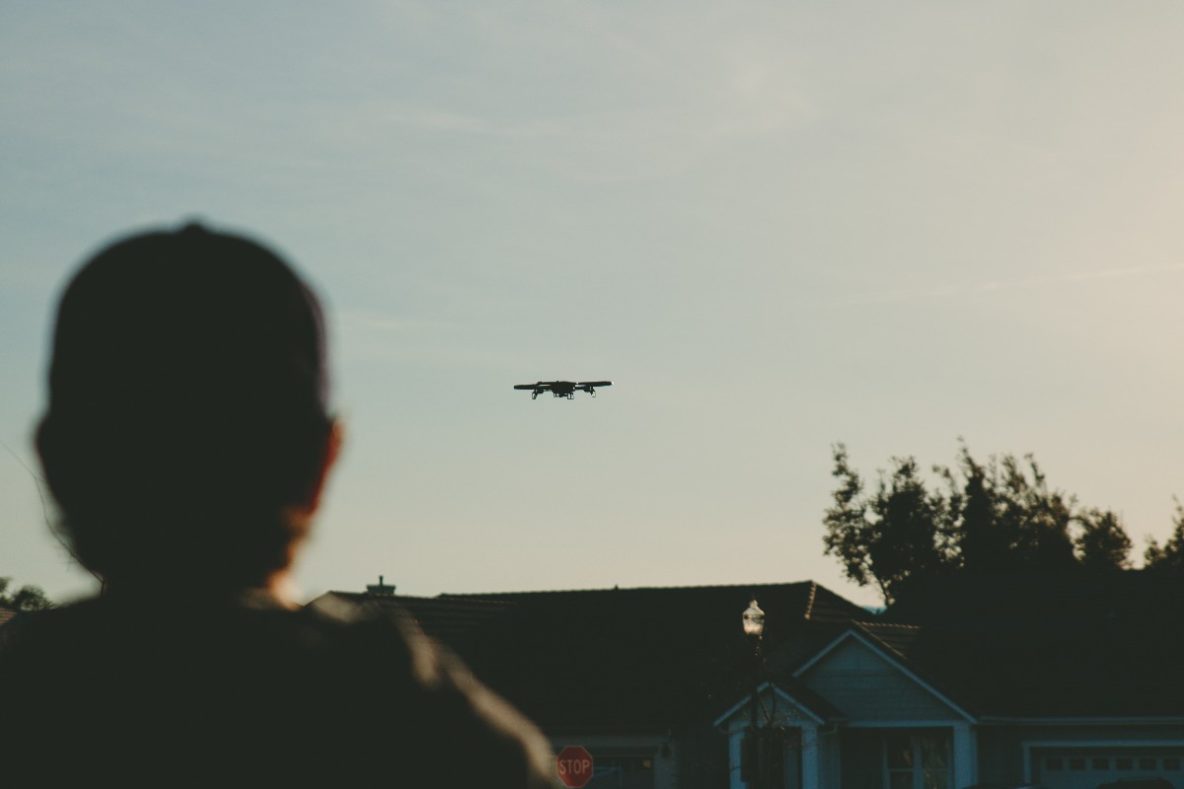Here you will find a glossary of common drone terminology and abbreviations that you may need to know.
0-9
2.4 GHz Drone Frequency
This drone frequency transfers data at a longer distance than 5.8 GHz but at slower speeds.
5.8 GHz Drone Frequency
This drone frequency transfers data faster but a shorter distance.
A
Accelerometer
A device that measures directional acceloration; used to stableize quadcopters.
AGL (Above Ground Level)
Refers to height a UAV is flying above ground level. For example, a drone flying 200 feet above a 70 foot hill would be 200 feet AGL and would then change to 270 feet AGL after flying over the hill.
Acro Mode
Also known as manual mode and rate mode. Arco mode doesn't automatically level the aircraft. This means that the pilot will have to constantly make adjustments to keep from losing control of the drone.
Aircraft
A device used for flight in the air.
Air Traffic Control (ATC)
A service provided by ground-based air traffic controllers (such as FAA in the US) who direct the safe and orderly flow of air traffic.
AMA (Academy of Model Aeronautics)
A non-profit organization dedicated to the promotion of model aviation as a recreational activity and recognized sport.
Atti Mode
DJI flight mode that is short for Attitude Mode, where the drone will maintain a specific altitude but not position. This means that the drone will maintain its height but the pilot will have to constantly adjust to maintain position.
Auto Leveling
A flight mode that allows the drone to perform even flight. This is typically an automatic feature that is engaged through a setting on the drone.
Autonomous Flight
Flight of UAVs that is controlled by internal programming, rather than a person with radio control, that directs the drone where to fly.
B
Barometric Altimeter (BARO)
An altitude measurement sensor that uses barometric pressure.
Bind
A procedure to link the drone to the controller.
Brushless Motor
Brushless motors are more efficient and durable when compared to brushed motors. They have permanent magnets that rotate around a fixed armature.
BVLOS (Beyond Visual Line of Sight)
The ability to operate an unmanned aircraft beyond the pilot's line of sight. This requires a special permit from the FAA in the USA.
C
Center of Gravity
The location where most of the aircraft's weight is located. The center of gravity needs to positioned almost perfectly in the center of the UAV to ensure level flight and stability in the air.
Certificate of Authorization (COA)
A waiver issued by the FAA that allows a public operator to perform specific UAS operations.
Commercial Drones
A UAS designed for heavy use with a specific purpose in mind such as package delivery, 3D mapping with LiDAR, search and rescue, and professional cinematography. Examples of commercial drones include the DJI Matrice 600 pro and the Freefly ALTA 8.
Controlled Airspace
Airspace of defined dimensions within which ATC services are provided. The level of control varies with different classes of airspace.
Collision Avoidance
A system the prevents pilots from flying into other aircrafts and fixed objects such as buildings, powerlines, trees, and towers.
Controller
A handheld device that uses radio signals to control the drone.
D
DJI
Acronym for Dà-Jiāng Innovations, which is the largest manufacturer of unmanned aerial vehicles (UAVs) and is based in Shenzhen China.
DJI Flight Modes
- S Mode
Stands for Sports Mode; S Mode allows the DJI drone to fly and maneuver twice as fast as normal. - P Mode
The standard flight mode that most pilots use. P Mode allows for precise hovering of the drone. All sensors are active including GPS, image, and infrared. - A Mode / Atti Mode
DJI flight mode that is short for Attitude Mode, where the drone will maintain a specific altitude but not position. This means that the drone will maintain its height but the pilot will have to constantly adjust to maintain position.
Drone
The common term used to describe UAVs (Unmanned Aerial Vehicles). This term is used to describe many types UAVs of different sizes and purposes ranging from toy quadcopters to military drones.
Dronie
A self portrait or self video captured using a camera drone.
E
eBee X
A fixed-wing drone produced by sensFly capable of covering more distance that a quadcopter used for carrying different payload options for photogrammetry, 3D mapping, multipectral, and infrared.
Electromagnetic Interference (EMI)
Electrical interference caused by proximity to metal, magnets, powerlines, or cell towers.
Elios
A collission tolerant intuitive and precise drone for indoor inspection.
ESC (Electric Speed Control):
An electronic device paired with the drones power suuply and flight controller to control speed and direction of the drones motors.
F
FAA (Federal Aviation Administration)
A United States Department of Transportation Agency with authority to oversee and regulate all aspects of American civil aviation.
Fail Safe
A system the helps protect a drone in case of an error. An example of this would be having the drone automatically return to home if signal is lost.
FC (Flight Controller)
The brain of a multirotor.
FOV (Field of View)
The measurement, in degrees, of how much can be seen through a camera lens.
FPV (First Person View)
The pilot sees what the drone sees through the use of a screen or mobile device.
Frequency
The radio frequency which FPV equipment runs on. Allows for multiple channels so pilots can find a channel with out interence from others.
G
Geofencing
A virtual geographic boundary created the the use of GPS and software to limit where a drone can and cannot fly.
GCS (Ground Control System
A device that measures directional acceloration; used to stableize quadcopters.
Gimbal
The mount on a drone where a camera sits; usually enables the camera to move and stabalize along multiple axes.
GIS (Geographic Information System)
A system used to capture, store, manipulate, analyze, manage, and present spatial or geographic data.
GLONASS/GNSS
Global Navigation Satellite System
Gyroscope
Assists with keeping a quadcopter level and while maintaning its reference direction.
H
Hexacopter
A multi-rotor aircraft with six rotors. The advantage of a hexacopter is that even if one engine fails, you will still beable to land the drone safely.
HIRTA (High Intensity Radio Transmission Area)
Flying through an HIRTA can interfere with the electronics on your drone.
Hobby Grade
An upgrade from a toy drone, these quadcopters are reliable at a reasonable price and are typically equipped with a camera.
I
IMU (Inertial Measurement Unit)
A controller that combines an accelerometer and a gyroscope, with the purpose of stabalizing and orienting a quadcopter.
INS (Inertial Navigation System)
A system that calculates position based on the initial GPS reading while incorporating speed and motion sensor readings. Usefull when a drone loses GPS signal.
IOC (Intelligent Orientation Control)
This sets the forward control of the drone to equal with where ever the nose of the drone is pointing.
IP Rating
A rating system used to classify the degree of protection that an electrical enclosure has against water and dust.
J
K
L
LAANC (Low Altitude and Notification Capability system)
LAANC allows drones access to controlled airspace in near real-time. It is a collaboration between the FAA and and private companies in support of UAS integration into national airspace.
Lithium Polymer Batter (LIPO)
Battery chemistry that offers more power and less weight than NiMh and NiCad batteries. Variants include: Lithium Ion.
LiDAR (Light Detection and Ranging)
A method of detecting, measuring, and mapping using a laser. Often used in more difficult to measure situations that require a higher degree of precision.
M
MAh (Milliampere hours)
Unit of measurement that describes the energy capacity of a battery.
METAR (Meteorological Terminal Aviation Routine Weather Report)
Also known as a Meteorological Aerodrome Report, METAR is a format for reporting weather information. A typical METAR usually contains data for temperature, dew point, wind direction and speed, precipitation, cloud cover and heights, visibility, and barometric pressure.
MSL (Mean Sea Level)
Altitude measured above the average height of the ocean/sea.
Multicopter
A rotorcraft with more than two propellers.
N
NOTAM (Notice to Airmen)
A notice provided to warn aircraft and pilots of any possible hazards or flight restrictions at a specific location or along a flight route.
O
Obstical Avoidance
A vision that allows UAVs to detect obstacles in its path and avoid collisions.
Octocopter
A multirotor aircraft with eight propellers.
P
Part 107
Regulations that define safety standards and restrictions for comercial drone operators created by the Federal Aviation Administration.
Photogrammetry
A method of mapping and surveying achieved by stitching photographs together to create one large image.
PIC (Pilot in Command)
The person who is ultimately responsible for the operation and safety during flight.
Pitch
Used to describe up and down movement along the vertical axis from the front to the back of the drone.
Professional Drone
A high-end UAV fitted with the latest technologies designed for a specific type of professional use such for professional media or for precision mapping.
Propeller
An angled blade used to create an area of high and low pressure to provide lift or thrust.
Q
Quadcopter
A multirotor with four propellers.
R
Racing Drone
A quadcopter that is designed to compete in first person view racing.
RTH (Return to Home)
A setting that the drone operator can trigger on the remote controll to tell the drone to automatically return to a set location if signal is lost or battery power is low.
Roll
Used to describe up and down movement on each side of the drone.
S
sUAS (Small Unmanned Aircraft System)
Unmanned aircraft systems that weigh less than 55lbs.
T
Telemetry
A two-way digital data stream that relays flight data and instructions between the UAV and ground station.
TFR (Temporary Flight Restriction)
A temporary restriction of all flight that applies to a specific area due to the presence of government VIPs, natural disasters, special events, and other unusual occurances.
Trim
Buttons on the controller used to control roll, pitch, yaw, and throttle.
U
UAS (Unmanned Aircraft System)
An unmanned aircraft, such as a quadcopter, controlled by an operator on the ground.
Uncontrolled Airspace
Airspace that has no ATC (air traffic control) services. Class F and Class G airspace is uncontrolled.
V
VLOS (Visual Line of Sight)
The operation of an UAV within the operator's direct line of sight without the aid of any device other than corrective lenses.
VO (Visual Observer)
An optional crew member whose job is to maintain visual contact with the UAV to ensure its safe operation.
W
Waypoints
A set of coordinates that define a point in space; used to create a flight path for UAVs.
X
Y
Yaw
Rotating the drone along its vertical access.
Z
Share this Post


